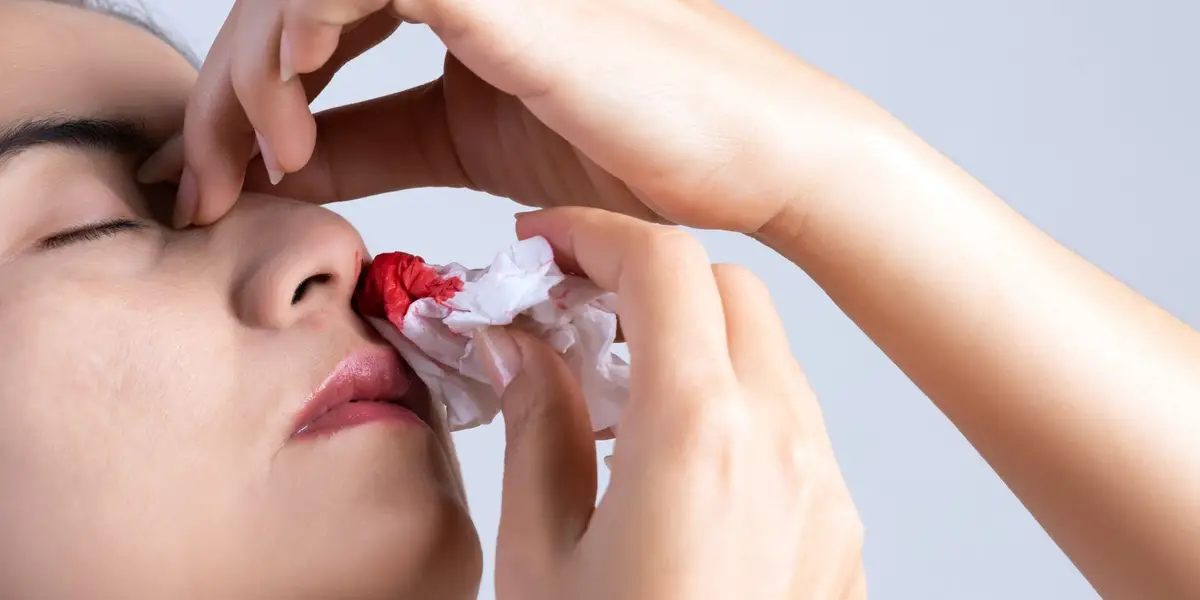Ever encountered a nosebleed? It’s difficult not to panic when blood starts gushing out of your nostrils, but knowing how to stop a nosebleed makes the situation a lot less stressful.
Even if you’re not a “person who gets nosebleeds,” having this first aid skill in your back pocket can come in handy if one ever surprises you, or someone close to you. In this article, we will take a look at the ways on how to stop a nosebleed in the safest way possible.
Table of Contents
What are the Types of Nosebleed?
Did you know that approximately 60% of people have had at least one nosebleed in their lives? And, as unpleasant as they may be in the moment, the vast majority aren’t serious. Yes, only 10% of all nosebleeds, known clinically as epistaxis, are severe enough to necessitate medical treatment.
A nosebleed occurs when the little blood vessels lining the inside of your nose rupture. When the blood is gushing, you usually won’t think about the type of nosebleed you have, but knowing the difference is vital since one can be treated at home and the other requires medical attention. The two types are anterior and posterior.
Anterior nosebleeds occur when blood vessels at the front of your nose rupture. Because there are so many blood arteries there, you may lose a lot of blood, which can make it feel and appear scarier than it is. The most common variety is anterior nosebleed, which usually involves just one nostril and can often be cured at home in just a few minutes.
Meanwhile, a posterior nosebleed occurs when larger blood vessels in the back of your nose burst. This is a more hazardous situation than an anterior nosebleed because the blood can travel to your throat and even down into your stomach, potentially causing nausea.
If you’re losing a lot of blood and quickly soaking through numerous tissues, unable to stop the bleeding on your own, bleeding from both nostrils, or swallowing or spitting up blood, you may have a posterior nosebleed and should go to the ER.
What Causes Nosebleed?
If you want to know how to stop a nosebleed, you must first learn that nosebleeds can occur for a variety of reasons, and some people have them far more frequently than others.
In certain situations, it comes down to anatomy: those with deviated septums, or crooked cartilage between both nostrils, may experience more frequent nosebleeds.
Moreover, you are more prone to have them if you have a blood clotting issue, such as haemophilia or von Willebrand disease. In addition to these risk factors, the following are some of the most common causes:
Dry Air
For those who want to know how to stop a nosebleed, the most prevalent causes of nosebleeds are low moisture and humidity. Dry, heated air can dry up the nasal membranes (the soft tissue within your nostrils), making them more prone to breaking and bleeding. A lot of people get nosebleeds during the cooler months when the humidity is reduced.
Injuries
Some nosebleeds develop as a result of physical damage to the face, such as being struck by a soccer ball or being in a vehicle accident. Nosebleeds caused by injuries are prevalent in youngsters; they can even occur from picking your nose too forcefully, which children are notorious for doing.
Inflammation or Irritation
Allergies, infections, and poor air quality can irritate or inflame your nose, a disease known medically as rhinitis. Nosebleeds can also be caused by common illnesses. When people get colds or the flu and have inflammation or irritation in their noses, the blood vessels in that area become more brittle.
Medications and Drugs
People who take or use certain medications, such as nasal steroid sprays, nonsteroidal anti-inflammatory drugs, or blood thinners, are more likely to experience nosebleeds. On the other hand, recreational substances such as cocaine can irritate the nasal lining and contribute to nosebleeds.
High Heights
Less oxygen implies drier air at high elevations. According to the Cleveland Clinic, if you are a hiker, frequently fly on planes, or reside high above sea level, you may be more prone to suffering a nosebleed on your trips.
How to Stop a Nosebleed Quickly
The good news is you don’t have to be a health professional to know how to stop a nosebleed quickly. In fact, you can do so in as little as a few minutes!
To stop nosebleeding quickly, the first step is to lean forward and place a tissue or cloth beneath your nose. Sit up and lean your head forward, chin down, so that the blood flows forward onto the tissue rather than backward down your throat. Seriously, don’t heed to any advise that encourages you to tilt your head downward, lay flat, or put your head between your knees.
Next, blow your nose gently. This should clear any tiny clogs that have formed in the nasal passages.
Then, squeeze the soft tip of your nose. Squeeze tightly on the bulbous section of your nose to halt the bleeding as this constricts the blood vessels and cuts off blood flow.
Remember, do not squeeze the bridge of your nose – it won’t injure you or make things worse, but it also won’t do anything. Maintain this pressure for at least 10 minutes, or up to 30 minutes if the bleeding hasn’t stopped after the first 10.
If the bleeding hasn’t stopped after squeezing, place an ice pack on the bridge of your nose to constrict the blood vessels and slow the flow.
Because all of that blood might become painful as it dries, you should wet a clean paper towel and carefully wipe away any extra blood. After a nosebleed, your nose will be sore, so don’t blow it or rub it too hard.
And if it doesn’t work…
If these methods don’t work and you get nosebleeds that are difficult to stop or are very painful or frequent, it’s time to see your doctor, who may evaluate you and send you to an ear, nose, and throat (ENT) specialist if necessary.
But chances are your nosebleeds aren’t serious—and if you’re bothered by them on a frequent basis, a doctor can give you some advice to help you prepare for the next time you see blood seeping from your nose.

